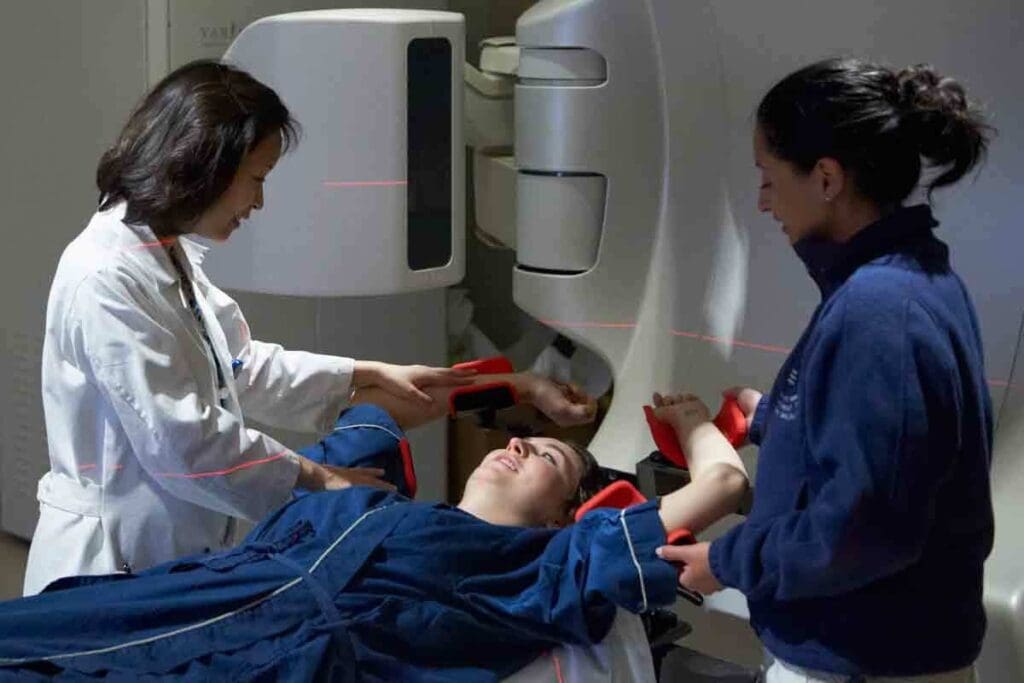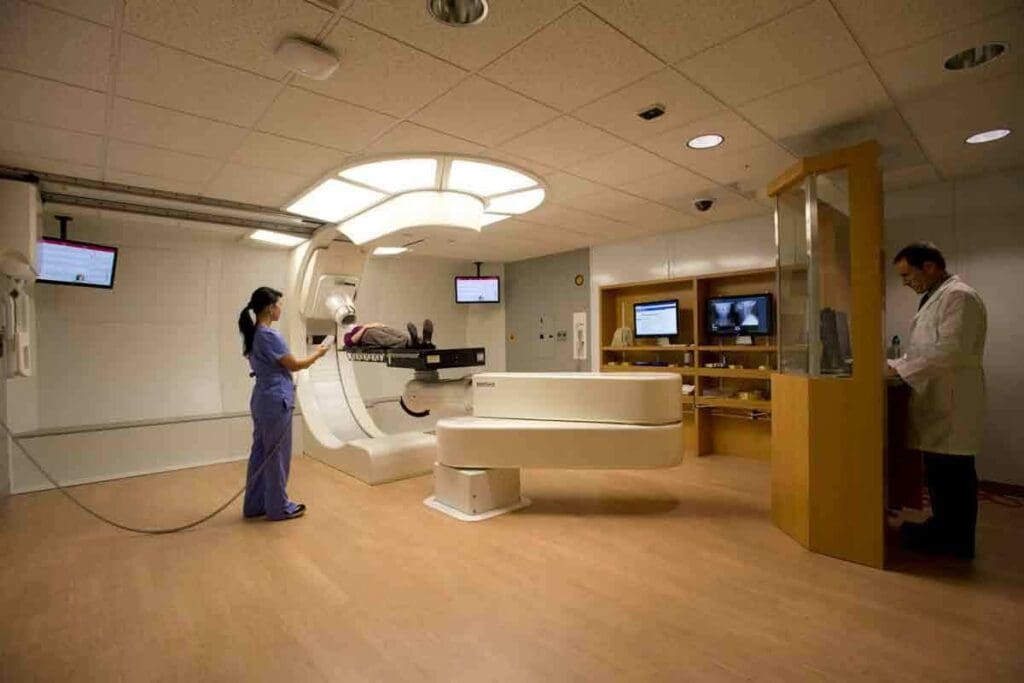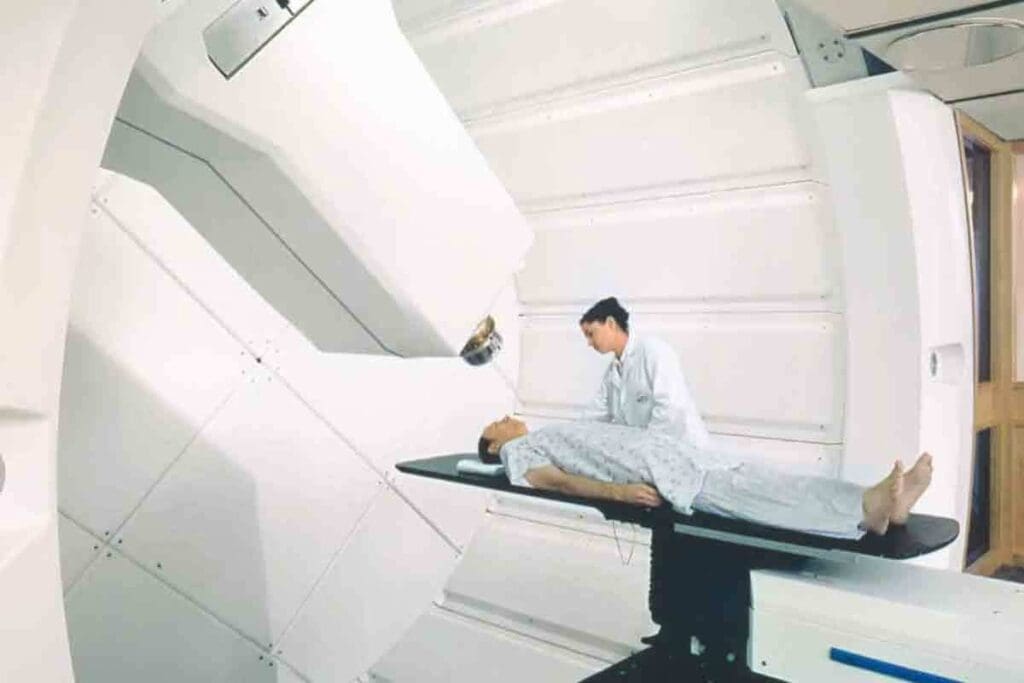Last Updated on November 27, 2025 by Bilal Hasdemir

We are seeing big steps forward in cancer treatment with systemic radiation therapy. This new method uses radioactive drugs to find and kill cancer cells all over the body. It’s a more accurate and effective way to treat cancer.
Systemic radiation therapy is different from old-school radiation therapy. It targets cancer cells all over, not just in one spot. This makes it better for treating cancer that has spread. It uses radioactive substances to find and kill cancer cells, which helps avoid harming healthy tissue nearby.
Key Takeaways
- Systemic radiation therapy is a targeted approach to treating cancer.
- It uses radioactive drugs to identify and destroy cancer cells throughout the body.
- This therapy offers a more precise treatment option compared to traditional radiation therapy.
- It is especially good for cancer that has spread.
- Liv Hospital offers top-notch systemic radiation therapy with a focus on the patient.
What Is Systemic Radiation and How Does It Work?

We use systemic radiation to fight cancer by putting radioactive substances in the body. This method helps target cancer cells all over the body. It’s a key treatment for many types of cancer.
Definition and Basic Principles
Systemic radiation therapy, or internal radiation therapy, uses radioactive materials that travel through the blood. They aim to destroy cancer cells. This method is great for cancers that have spread to different parts of the body. The American Cancer Society says it’s a treatment that uses radioactive substances to target cancer cells.
The basic idea is to get radioactive materials to cancer cells without harming healthy tissues. This is done through different ways, like pills and injections.
| Delivery Method | Description | Advantages |
| Oral Pills | Radioactive substances enclosed in capsules or tablets | Easy to administer, non-invasive |
| Intravenous Administration | Radioactive materials are injected directly into the bloodstream | Rapid distribution throughout the body |
How It Differs from External Beam Radiation
Systemic radiation therapy is different from external beam radiation therapy. External beam radiation uses beams from outside the body to target cancer cells. Systemic radiation, on the other hand, puts radioactive materials inside the body. This lets systemic radiation reach cancer cells all over the body, making it good for treating cancer that has spread.
Key differences between systemic and external beam radiation:
- Method of delivery: Systemic radiation is internal, while external beam radiation is, as the name suggests, external.
- Scope of treatment: Systemic radiation can target cancer cells throughout the body, whereas external beam radiation is typically focused on a specific area.
Understanding these differences helps us see the special benefits and uses of systemic radiation therapy in fighting cancer.
Delivery Methods: Oral Pills vs. Intravenous Administration

Healthcare providers have two main ways to give systemic radiation: oral pills and intravenous (IV) therapy. The choice depends on the cancer type, its stage, and what the patient prefers.
Radiation Pills: Composition and Administration
Radiation pills are taken by mouth. They have a radioactive isotope that targets cancer cells. The type of isotope used can vary, like iodine-131 for thyroid cancer.
It’s easy to give out radiation pills. Patients get clear instructions on how to take them safely. The dose and how often to take it depend on the treatment plan.
Liquid Radiotherapy: IV Delivery Systems
Liquid radiotherapy uses IV lines to put radioactive substances into the blood. This method targets cancer cells all over the body. It’s used for cancers like lymphoma and leukemia.
Using IV systems requires careful planning and monitoring. Doctors must make sure the radioactive material is given right and the patient is safe during and after treatment.
Choosing Between Oral and Intravenous Options
Choosing between oral pills and IV therapy depends on several things. These include the cancer type and stage, the patient’s health, and their personal choices. For example, oral pills might be better for some thyroid cancers, while IV therapy is better for cancers that have spread.
- Type and stage of cancer: Different cancers respond better to different delivery methods.
- Patient’s overall health: The patient’s condition can influence the choice between oral and IV administration.
- Patient preferences: Some patients may prefer oral medication over IV therapy due to its convenience and less invasive nature.
In the end, the choice between oral pills and IV therapy is made for each patient. Healthcare providers pick the safest and most effective treatment option.
Types of Cancer Treated with Systemic Radiation
Many cancers are treated with systemic radiation, giving hope to patients everywhere. This therapy is a key part of cancer care, targeting cancer cells effectively.
Thyroid Cancer Treatment
Systemic radiation is a mainstay for some thyroid cancers. It uses radioactive iodine to kill thyroid cells, including cancer cells. This works well for certain thyroid cancer types.
Radioactive iodine has been a key treatment for years. It’s safe and effective for many patients.
Prostate Cancer Applications
It’s also used for prostate cancer, mainly when it has spread. Radium-223 is a drug that targets cancer in bones. It helps manage pain and prevent bone damage.
Bone Metastases Management
Bone metastases are common in cancers like breast, prostate, and lung. Systemic radiation, with drugs like radium-223, helps manage these. It reduces pain and improves life quality.
Other Approved Cancer Types
Systemic radiation is also being tested for other cancers. Research aims to treat more types of cancer with this therapy. This could open up new treatment options for patients.
Systemic radiation therapy is a big step forward in cancer treatment. It offers targeted care for many cancers. As research grows, we’ll see more uses for this therapy.
How Radiation Pills and Liquid Therapy Target Cancer Cells
Systemic radiation therapy is a precise treatment that targets cancer cells throughout the body. It’s great for treating cancers that have spread or are at risk of spreading. We’ll look at how radiation pills and liquid therapy target cancer cells and the science behind it. We’ll also see how they minimize damage to healthy tissues.
The Science of Cancer Cell Targeting
Radiation therapy damages the DNA inside cancer cells, stopping them from growing and dividing. Radiation therapy can be given systemically through pills or liquid to reach cancer cells all over the body. The goal is to give cancer cells enough dose while keeping healthy tissues safe.
Minimizing Damage to Healthy Tissues
To protect healthy tissues, the dosage and delivery method of systemic radiation are carefully planned. The choice between oral pills and intravenous administration depends on the cancer type, location, and the patient’s health. Precise targeting is key to reducing side effects and improving treatment results.
Radiation Half-Life Considerations
The half-life of a radioactive substance is a key factor in systemic radiation therapy. It shows how long the radioactive material stays active in the body. A substance with the right half-life stays active long enough to target cancer cells but not too long to cause unnecessary radiation exposure.
| Aspect | Description | Importance |
| Cancer Cell Targeting | Damaging DNA in cancer cells | Prevents cancer cell growth and division |
| Minimizing Damage | Careful dosage planning | Reduces side effects |
| Radiation Half-Life | Duration radioactive substance remains active | Ensures effective treatment with minimal prolonged exposure |
Benefits of Systemic Radiation for Widespread Cancer
Systemic radiation therapy is a broad approach to fighting cancer that has spread. It’s great for patients with cancer that has spread all over. This method targets cancer cells in many places at once.
Addressing Metastatic Disease
Metastatic disease is hard to treat because cancer cells are in many parts of the body. Systemic radiation therapy aims to fight this by treating cancer cells everywhere. It helps control the disease and reduce symptoms.
This treatment is good because it can reach cancer cells in different spots. It’s very helpful for patients with cancer in many places. It lets us treat all the cancer spots at once.
Reaching Cancer Cells Throughout the Body
Systemic radiation therapy can reach cancer cells all over the body. This makes it a strong treatment for cancer that’s spread out. It can hit cancer cells in spots that are hard to get to with other treatments.
This is very useful for cancers that like to spread a lot. For example, some thyroid and prostate cancers spread a lot. Systemic radiation is a good choice for these cancers.
| Cancer Type | Systemic Radiation Benefits | Localized Treatment Limitations |
| Thyroid Cancer | Targets cancer cells in multiple locations, including metastases | May not effectively address widespread disease |
| Prostate Cancer | Can target cancer cells that have spread to bones and other areas | It may not be effective for patients with multiple metastases |
When Systemic Radiation Is Preferable to Localized Treatment
Systemic radiation therapy is better in some cases. It’s good for patients with cancer that has spread a lot. It also works well for cancers that tend to spread a lot.
We think systemic radiation is a great option for patients with widespread cancer. It treats cancer cells all over the body. This gives a full treatment plan.
Radioactive Chemotherapy: The Evolution of Targeted Therapy
Radioactive chemotherapy is a big step forward in fighting cancer. It combines chemotherapy with the power of radioactive substances. This mix has shown great promise in treating different cancers.
Combining Radioactive Drugs with Chemotherapy
Radioactive chemotherapy uses drugs with radioactive isotopes. These isotopes kill cancer cells with radiation, but spare healthy tissues. Radioimmunotherapy is a key example. It uses a radioactive tag attached to a cancer-targeting antibody.
This method makes treatments more effective. It targets cancer cells better, reducing harm to healthy cells. This could also lower the side effects of traditional chemotherapy.
Latest Innovations in Radioactive Chemotherapy
New advancements in radioactive chemotherapy aim to improve delivery and effectiveness. Scientists are looking into new isotopes and better targeting methods. This could make these therapies even more precise.
Radioimmunotherapy is showing great promise, mainly in treating lymphomas and leukemias. It delivers radiation directly to cancer cells, opening new treatment paths.
Case Studies and Success Rates
Many case studies highlight the success of radioactive chemotherapy. For example, advanced lymphoma patients have seen remarkable improvements with radioimmunotherapy. Some have even achieved complete remission.
The success of these treatments depends on the cancer type, its stage, and the treatment used. But overall, the results are encouraging. Many patients are living longer and enjoying a better quality of life.
Combination Therapies: Improving Treatment Outcomes
Using systemic radiation with other treatments has shown great promise. It combines the strengths of different therapies. This makes cancer care more effective.
Systemic Radiation with External Beam Therapy
One effective mix is systemic radiation and external beam therapy. External beam therapy hits cancer cells from outside. Systemic radiation attacks from inside. This combo is great for cancers that spread a lot.
In cases of metastatic prostate cancer, systemic radiation targets cells all over. External beam therapy focuses on specific areas. This can lead to better tumor control and outcomes.
Integration with Immunotherapy
Another exciting area is combining systemic radiation with immunotherapy. Immunotherapy boosts the body’s fight against cancer. When paired with radiation, it can make the immune system attack cancer cells better.
- Stimulating the immune system to recognize and attack cancer cells more effectively
- Potentially improving response rates to immunotherapy
- Offering new hope for patients with advanced or hard-to-treat cancers
Research on Combined Treatment Approaches
Research is key to improving combination therapies with systemic radiation. Studies are looking into:
- Optimal sequencing of different therapies
- Dosing strategies for combined treatments
- Patient selection criteria for different combination approaches
As research grows, we’ll see better and more tailored treatments for cancer patients.
Side Effects and Safety Considerations
Systemic radiation therapy needs careful thought about side effects and strict safety rules. We’ll look at radiation pills and liquid treatments. It’s key to know how to keep patients and caregivers safe.
Common Side Effects of Radiation Pills
Radiation pills can cause side effects because of the radioactive stuff in them. Common issues include:
- Fatigue
- Nausea and vomiting
- Changes in skin and hair
- Salivary gland issues
These side effects can be managed with the right medical care. Patients need to stick to their treatment plan. They should also tell their doctor about any bad effects.
Risks Associated with Liquid Radiation Treatment
Liquid radiation treatment, given through an IV, has its own risks. These include:
- Infection at the injection site
- Allergic reactions to the radioactive material
- Potential damage to the bone marrow
Healthcare providers watch patients closely during and after treatment. They adjust the plan as needed to lower risks.
Safety Protocols for Patients and Caregivers
There are strict safety rules for patients getting systemic radiation therapy and their caregivers. These include:
- Guidelines for handling bodily fluids
- Precautions to minimize exposure to others
- Proper disposal of radioactive materials
By following these rules, we can greatly reduce the risks of systemic radiation therapy.
Long-term Monitoring Requirements
Long-term checks are key for systemic radiation therapy. Patients need regular visits to watch for long-term side effects, like:
- Thyroid problems
- Secondary cancers
- Other possible late effects
This ongoing monitoring helps healthcare providers catch and fix any issues quickly. It ensures the best results for patients.
Conclusion: The Future of Systemic Radiation Therapy
Systemic radiation therapy is a big step forward in fighting cancer. It uses pills or liquid therapy to attack cancer cells all over the body. This gives hope to many patients with different types of cancer.
The outlook for radiation therapy is bright. Research and new technologies are making treatments better and safer. This means patients with cancer that has spread can now have more options.
New radioactive isotopes and delivery systems are leading to better treatments. As these technologies get better, we’ll see even more effective ways to fight cancer.
Systemic radiation therapy is set to be a key part of cancer treatment’s future. We’re dedicated to providing top-notch care and support to patients worldwide.
FAQ
What is systemic radiation therapy?
Systemic radiation therapy uses radioactive substances to fight cancer cells all over the body. It’s a way to treat cancer from the inside.
How does systemic radiation therapy differ from external beam radiation therapy?
Systemic radiation therapy targets cancer cells inside the body. It uses radioactive substances. External beam radiation therapy, on the other hand, uses a machine to send beams from outside the body to target cancer cells.
What are the delivery methods of systemic radiation therapy?
Systemic radiation therapy can be given as oral pills or through an IV. The choice depends on the cancer type and what the patient prefers.
What types of cancer are treated with systemic radiation therapy?
It treats many cancers, like thyroid, prostate, and bone metastases. It’s also used for other approved types of cancer.
How do radiation pills work?
Radiation pills have radioactive substances that cancer cells absorb. This allows for targeted treatment all over the body.
What are the benefits of systemic radiation therapy for widespread cancer?
It offers a complete cancer treatment that has stopped with spread. It addresses cancer cells all over the body.
What are the common side effects of radiation pills?
Side effects can include fatigue, nausea, and changes in blood counts. These depend on the treatment and the patient.
How is radioactive chemotherapy used in cancer treatment?
It combines radioactive drugs with chemotherapy. This makes cancer treatment more effective, marking a big step forward.
What are the safety considerations for patients undergoing systemic radiation therapy?
Patients need close monitoring and follow-up. This is to keep risks low and ensure safety, including for caregivers.
Can systemic radiation therapy be used in combination with other treatments?
Yes, it can be used with other treatments like external beam therapy and immunotherapy. This can improve treatment results.
What is the role of radiation half-life in systemic radiation therapy?
Radiation half-life is key. It shows how long the radioactive substance works. This helps protect healthy tissues.
How is liquid radiotherapy administered?
It’s given through an IV. This allows for targeted treatment of cancer cells all over the body.
What are the advantages of intravenous radiation therapy?
It’s a targeted way to treat cancer. Radioactive substances are delivered directly into the bloodstream. This reaches cancer cells all over the body.
Reference:
PubMed Central. (2024). Systemic radiotherapy using targeted isotopes is the best approach. https://pmc.ncbi.nlm.nih.gov/articles/PMC11539965






